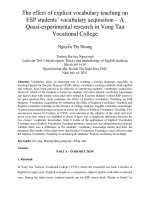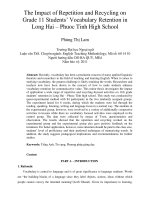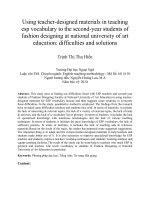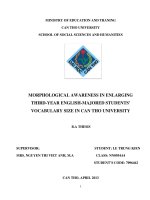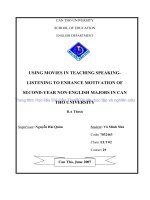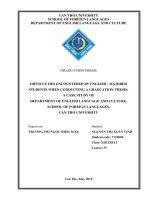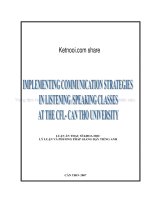morphological awareness in enlarging thirdyear englishmajored students vocabulary size in can tho university
Bạn đang xem bản rút gọn của tài liệu. Xem và tải ngay bản đầy đủ của tài liệu tại đây (274.69 KB, 41 trang )
MINISTRY OF EDUCATION AND TRANING
CAN THO UNIVERSITY
SCHOOL OF SOCIAL SCIENCES AND HUMANITIES
MORPHOLOGICAL AWARENESS IN ENLARGING
THIRD-YEAR ENGLISH-MAJORED STUDENTS'
VOCABULARY SIZE IN CAN THO UNIVERSITY
B.A THESIS
SUPERVISOR:
STUDENT: LE TRUNG KIEN
MRS. NGUYEN THI VIET ANH, M.A
CLASS: NN0954A4
STUDENT’S CODE: 7096462
CAN THO, APRIL 2013
1
ACKNOWLEDGEMENTS
Firstly, I would like to express my appreciation to my supervisor, Mrs. Nguyen
Thi Viet Anh for her insightful guidance and support. Her expertise about
morphological awareness and vocabulary knowledge, her thoughtful questions
and her reflections on my work, all challenged me to deeply think about the
topic.
Second, I owe thanks to the some of my teachers who helped me during my
thesis progess: Ms. Vo Thi Tuyet Hong, B.A, Ms. Ly Thi Anh Tuyet, B.A, and
especially, Mr. Nguyen Hong Qui, M.A who allowed me an access to the
participants.
Finally, I would like to thank my father and mother for their assurance and
support throughout the process of writing the thesis.
2
Announcement of copy right with the researchers’ and supervisor’s
signiture
Researcher:
Supervisor:
3
TABLE OF CONTENTS
ACKNOWLEDGEMENTS………………………………………………..i
TABLE OF CONTENTS…………………………………………………iii
LIST OF CHARTS AND FIGURES……………………………………..iv
TÓM LƯỢC……………………………………………………………….vi
ABSTRACT………………………………………………………………..vii
CHAPTER 1: INTRODUCTION………………………………………….1
1.1. Statement of the problem………………………….……………….1
1.2. Background information………………………..………………….2
1.3. Aims of the research………………………………………………..3
1.4. Significance of the research………………….……………………..3
1.5. Thesis organization………………………...……………………….4
CHAPTER 2: LITERATURE REVIEW………...……………………….5
2.1. Definitions of technical terms………………..……………………..5
2.2. Review of the related literature…………………………………….9
2.3. Summary and indications…………………………………………..12
2.4. Research question(s)…………………………..………………...….13
2.5. Research hypothesis(es)………………………………………….....13
CHAPTER 3: RESEARCH METHODOLOGY………………………….14
4
3.1. Research design……………………………………………………. ...14
3.2. Sample and sampling………………………….…………………….. 14
3.3. Data collection………………………………….……………………..14
3.3.1. Measuring instrument(s)…………………….…………………..14
3.3.2. Procedure…………………………………………………………14
3.5. Data analysis…………………………………………………………..15
CHAPTER 4: RESULTS, DISCUSSION, AND CONCLUSION……….…17
4.1 Research results……………………………………………………..…17
4.2. Discussion………………………………………………………………20
4.3. Conclusion……………………………………………………….……..22
CHAPTER 5: LIMITATIONS AND RECOMMENDATION………..……23
5.1. Limitations of the research…………………………………………....23
5.2. Recommendation………………………………………………………23
- REFERENCES………………………………………………………….........viii
- APPENDIX 1…………………………………………………………………x
- APPENDIX 2……………………………………………………………...…xiii
5
LIST OF CHARTS AND FIGURES
- CHART 1: Students’ rate of marks in prefixes, suffixes and roots in two
tests………………………………………………………………………………………..18
-CHART 2: Students’ changes of mark percentage through five scales in
Morphology pre-tests and post-tests………………………………………………….19
6
TÓM LƯỢC
Nhiều nghiên cứu liên quan tới vai trò của việc nhận thức về hình vị trong tiếng
Anh lên việc mở rộng vốn từ vựng đối với người học tiếng Anh như là ngôn ngữ
thứ 2 đã được tiến hành ở nhiều nơi trên thế giới. Tuy vậy, nhiều nhà nghiên cứu
vẫn còn đang bàn cãi về chủ đề này. Nghiên cứu hiện tại nhằm tìm ra tỷ lệ điểm
số của sinh viên rơi vào hình vị nào là thấp nhất (tiền tố, hậu tố hay gốc từ) để từ
đó chú trọng hơn đối với hình vị đó, đồng thời kiểm tra xem liệu có tác động nào
của kiến thức hình vị của sinh viên lên việc mở rộng vốn từ của họ hay không.
Nghĩa là người nghiên cứu đi tìm lời đáp cho 2 câu hỏi: (1) Trong bài kiểm tra về
kiến thức hình vị của sinh viên gồm 3 phần, phần hình vị nào sinh viên có điểm số
thấp nhất? (không nằm trong mục “Các bài nghiên cứu có liên quan”, nhưng câu
trả lời tìm ra được từ kết quả của bài nghiên cứu) (2) Liệu có tác động nào của
kiến thức hình vị của sinh viên lên việc mở rộng vốn từ của họ hay không? Đối
tượng tham gia trong bài nghiên cứu này là 75 sinh viên năm thứ 3 chuyên ngành
tiếng Anh. Phương pháp nghiên cứu thực nghiệm được áp dụng trong bài nghiên
cứu. Các kết quả cho thấy, trước tiên, trong 3 loại hình vị, phần gốc từ là phần
sinh viên có tỷ lệ điểm thấp nhất, và thứ hai là, sinh viên có kiến thức hình vị
càng nhiều bao nhiêu, sẽ dễ dàng hơn cho họ bấy nhiêu trong việc tìm ra nghĩa
của từ vựng mà họ bắt gặp.
7
ABSTRACT
A lot of research related to the role of English morphological awareness in enlarging
EFL learners’ vocabulary size has been conducted in many parts of the world.
However, there are still arguments about this topic amongst the researchers. The
present study aims at finding out in which part (prefixes, suffixes, roots) the students’
marks are the worst and need to be paid attention to more, and investigating the effect
of students’ morphological awareness on their vocabulary size, that means it answers
the two questions: (1) Amongst the three kinds of morphemes (prefixes, suffixes and
roots) included in the tests as the separated part of multiple choice questions, which
is at the lowest rate of marks?(This is not included in Literature Review part, but the
answer comes from the results of the study), (2) Is there a relationship between
students’ English morphological awareness and their vocabulary size? The
participants are 75 third-year students of English in Can Tho University. The
experimental research method is used in the study. The findings showed that, first,
amongst the three kinds of morphemes (prefixes, suffixes and roots) included in the
tests, the part of multiple choice questions on roots is at the lowest rate of marks, and
second, the more morphological awareness the students have, the more easily they
can figure out the meanings of new words that they come across.
8
CHAPTER 1: INTRODUCTION
1.1 Statement of the problem
Vocabulary is part and parcel of every language. Vocabulary items are sets of words
which form the basis for producing and understanding sentences (Miller,
1991).Therefore, “without some knowledge of that vocabulary, neither language
production nor language comprehension would be possible” (Angelin, Miller &
Wakefield, 1993).
As you might know, to master a language, there are four main skills namely Listening,
Speaking, Writing and Reading, and knowledge from generality to details related to
that language practiced and accumulated intentionally and regularly. However, maybe,
not all of language learners have realized the importance of vocabulary acquisition
during their study. In fact, possessing a large amount of vocabulary can help learners
to easily access those skills and the knowledge, leading them to language proficiency.
1.2 Background information
According to Nation (1993), vocabulary knowledge is one of the language skills
crucial for fluent language use. To him, knowledge of around 3,000 word families is
the threshold needed for tapping other language skills. Without this threshold, learners
encounter problems understanding the language they are exposed to (Alderson and
Banerjee, 2002). Vocabulary size is an indicator of how well the second language (L2)
learners can perform academic language skills such as, reading, listening, and writing
(Bear, Invernizzi, Templeton and Johnston, 2008; Treiman and Casar, 1996). Ellis
(1997) argues that vocabulary knowledge is a predicator of learners’ discourse
comprehension, which allows grammatical rules to be patterned in the learners’ mind.
Having inadequate vocabulary hampers learners’ reading comprehension in a way that
makes it more likely the learners will face difficulties in the path of academic
9
achievement. English is not an exception. A fundamental way to dominate English is
that learners must have as much vocabulary knowledge as possible.
Understanding its importance, a lot of researchers have conducted studies to find out
the most effective strategies for learning English vocabulary. One method is applying
morphological knowledge to infer the meanings of new words. In this method,
students apply morphological analysis when they read or hear a complex word that
they have never encountered before. They analyze the words to see if they recognize
any of the pieces (White, Power, & Sheida, 1989). Because English has borrowed
many words from different foreign languages, students should learn how to analyze
the different parts of any new word. Mastering such skills will equip students with a
useful tool to decode most unfamiliar words in a given text (Nation, 2001). Other
researchers (Morin, 2003; McBride-Chang, Wagner, Muse, Chow, & Shu, 2005;
Schiff & Calif, 2007) have also suggested that using morphological cues for inferring
meaning can help with L2 learning.
It is recommended that students are taught to identify affixes and Greek and Latin
roots in English words in order to predict the meanings of unknown vocabulary.
Through analyzing words into recognizable roots and affixes, classroom teachers can
demonstrate that each isolated element of words can provide informational clues
(Brown, 1994; Aebersold & Field, 1997). Certain affixes are more useful than others,
so when students are instructed to which affixes they should pay more attention to,
they can be less frustrated. The most important affixes are claimed to be the
combining forms, prefixes, or suffixes that carry single, invariant meanings. However,
students should not be exposed to long lists of affixes in isolation. Rather, teachers
should present affixes as they are in need; to analyze the structure of the words that
students will encounter in an assigned reading text (Vacca & Vacca, 1989; Seal, 1991;
Johnson & Steele, 1996).
Although morphological analysis is not the only strategy teachable to enhance
learners’ vocabulary size, it is a potential learning strategy that seems particularly
10
useful for the learners when attempting to tackle the meanings of new words (Badriya
Al Farsi, 2008).
Therefore, in my study, I focus on checking whether the knowledge of morphological
awareness of 3rd-year students in English major in Can Tho University can help them
enlarge their vocabulary size effectively. Besides, some implications on English
language learners who want to challenge themselves with TOEFL Reading sections or
who deal with Reading texts should be offered.
1.3 Aims of the study
The study aims at investigating the part in which the students get the lowest rate of
marks, and whether there is a relationship between students' morphological awareness
and their English vocabulary size.
1.4 Significance of the research
The findings of the study proved that, with the morphological awareness, the students'
vocabulary size could be enlarged significantly. Moreover, amongst the 3 parts of the
test, the prefix-checking part was the one in which the number of the correct answers
was the most while the number of the correct answers was the least in the rootchecking part. However, through the two tests, the researcher recognizes that although
there are improvements on students’ morphological awareness in the three parts, the
number of the correct answers in root-checking part was still under the average point.
1.5 Organization of the thesis
There are totally five chapters in the present study. Chapter 1: Introduction; Chapter 2:
Literature Review; Chapter 3: Research Methodology; Chapter 4: Results, Discussion
and conclusion, Chapter 5: Limitations and Recommendation.
Chapter 1 presents the statement of the problem, background information. Also, aims
of the research and significance of the research are mentioned in the chapter.
11
Chapter 2 includes 5 parts. They are: Definitions of technical terms, Review of the
related literature, Summary and Indications, Research question(s), and Research
hypothesis(es).
Chapter 3 focuses on Research design, Sample and sampling, Data collection and Data
analysis. In Data collection part, detailed descriptions of measuring instrument(s) and
procedure are included.
Chapter 4 presents the Results of the study, Discussion and Conclusion.
Chapter 5 discusses Limitations of the study and Recommendation for it.
12
CHAPTER 2: LITERATURE REVIEW
2.1 Morphology and Morphemes
2.1.1. Definition of Morphology
The term “morphology” is derived from the Greek word “morph”, which means
shape. In linguistics, “morphology” refers to the mental system involved in word
formation or to the branch of linguistics that deals with words (their interior structure,
and how they are formed) (Aronoff & Fudeman, 2005). According to Michael J.
Kiefer & Nonie K. Lesaux, the word “morphology” can be broken down into two
meaningful parts: “morph”- meaning shape, and “ology” - meaning the study of. Thus,
“morphology”, in its most generic form, is the study of shape. In addition, they say
that, in language and reading, “morphology” refers to the study of the structure of
words. Moreover, in terms of linguistics, “morphology” is the identification, analysis
and description of the structure of a given language's morphemes and other linguistic
units, such as root words, affixes, parts of speech, intonation/stress, or implied context
(words in a lexicon are the subject matter of lexicology) (“Morphology” (linguistics)Wikipedia, the free encyclopedia). “Morphology”, on the views of Leong and
Parkinson (1995), is the study of the hierarchical and relational aspects of words and
the operation on lexical items according to word formation rules to produce other
lexical items. Another definition on “morphology” comes from Kordula De Kuthy
(2001). According to him, “morphology” is the study of basic building blocks of
meaning in language. Last but not least, “morphology” is defined as “the area of
grammar concerned with the structure of words and with relationships between words
involving the morphemes that compose them” (McCarthy, 2002).
2.1.2 Definition of morphemes
A morpheme is, by definition, a meaningful linguistic unit that contains no smaller
meaningful units (Evelyn Hatch and Cheryl Brown 2007: 261). In another view, the
13
term “morpheme” refers to the smallest, visible unit of semantic content or
grammatical function of which words are made up (Katamba, 1993). According to
him, “morphemes” can be divided into four general classes: free, bound, derivational,
and inflectional morphemes. “Free morphemes” are those which can stand alone in
words such as dog, cat, and house. “Bound morphemes” must be attached to other
morphemes to make sense, such as un-, dis-, and ex-. “Derivational morphemes”
create new words by changing the part of speech or the meaning, e.g. legal /illegal.
“Inflectional morphemes” add a grammatical element to the word without changing its
meaning or part of speech, e.g. book/books.
Also, there is a very creative definition of “morphemes”. According to Norah Sultan
Alsalama (2011), “morphemes” can be compared to Lego pieces. The same
morphemes can be attached to different words to compose new words. For example,
the morpheme un- can be attached to a large number of words, e.g. unsafe, unhappy,
and unorganized. Yet, some morphemes are limited to a few numbers of words, such
as the morpheme “–dom”, which is found in words such as kingdom. The roots of
complex words of Germanic origin are usually free morphemes, such as the word
“festschrift”, a book prepared by colleagues to honor a scholar, often on an important
birthday, such as the “sixtieth”.
2.2 Morphological Awareness
“Morphological awareness” is the ability to combine familiar spoken units of
meaning or morphemes (the smallest meaningful units of words) to create new
meanings that can be used as an indicator or reading development (Carlisle, 1995). To
another view, “morphological awareness” refers to students’ understanding of the
structure of words as combinations of the smallest meaningful units of word- known
as morphemes (Michael J.Kieffer- Nonie K. Lesaux, 2007). From a broader
perspective, “morphological awareness” refers to a learner’s grasp of morphological
structure, as well as his or her capability of using the knowledge during
morphological processing in visual word recognition (Koda, 2000). The conscious
14
ability to think about and manipulate morphemes in words is called “morphological
awareness” (Carlisle, 1995; McBride-Chang, Wagner, Muse, Chow, & Shu, 2005).
One aspect of “morphological awareness” is the ability to recognize relations
between base words and derived words (e.g., fun-funniest;Tyler & Nagy, 1989). Also,
“morphological awareness” is defined as the ability to use the knowledge of word
formation rules and the pairings between sounds and meanings (Kuo & Anderson,
2006). With morphological awareness, learners are able to learn morphemes and
morphemic boundaries by disassembling complex words into meaningful parts (e.g.
childhoods= child+ -hood+ -s), learning the meanings of roots, affixes (child= baby, hood= the state of being, -s= to indicate plural nouns), and reassembling the
meaningful parts into new meanings (motherhood, fatherhood, brotherhood).
2.3 Vocabulary size
2.3.1 Definition of Vocabulary
“Vocabulary” is knowledge of words and word meanings. “Knowing a word is a
matter of degree rather than all or nothing. Knowing a word implies knowing how that
word relates to other knowledge and being able to recognize its connotations and
subtleties.” (Heibert, Lehr & Osborn). Vocabulary, following another definition (
Oxford Advanced Learner’s dictionary), is all the words that a person knows or uses.
2.3.2 Vocabulary through morphemes
Vocabulary through Morphemes enables students to both deepen their present word
knowledge and to better understand unknown words encountered in the future.
Vocabulary growth should be seen in terms of breadth of knowledge (how many
words do you know?) and depth of knowledge (how well do you know the words
that you do know?), as described by Bowers & Kirby (2009) and Baumann et al.
(2002).
2.3.3 Vocabulary size
15
“Vocabulary size” is an indicator of how well the second language (L2) learners can
perform academic language skills such as, reading, listening, and writing (Bear,
Invernizzi, Templeton and Johnston, 2008; Treiman and Casar, 1996). In another
view, “vocabulary size” refers to the number of words of which some aspect of
meaning is known to the learners (Badriya Al Farsi, 2008).
2.4 The role of morphemes to vocabulary size
“Morphemes” include affixes (prefixes and suffixes) and roots or stems. Knowing
some common “affixes” and “roots” can help students learn the meaning of many new
words. For example, if students learn just the four most common prefixes in English
(un-, re-, in-, dis-), they will have important clues about the meaning of about two
thirds of all English words that have prefixes (Nation, 2001). Schmitt and Meara
(1997) mentioned that explicit training is required for learners to expand their
knowledge of morphology, as EFL learners who know a base form (e.g., simple) do
not necessarily acquire other forms of the word (e.g., simplify). Observations indicates
that for the majority of poor readers the basic source of their difficulty is failure to
develop accurate and efficient (i.e., automatic) word recognition skills (Stanovich,
1986, 1992). Poor decoding skills may, in turn, place comprehension processes at risk,
due in part to the fact that poor readers devote so much attention to the decoding task
that there are not enough cognitive resources left for construction of meaning
(Näslund, & Samuels, 1992; Stanovich, 1986, 1992). Kuo and Anderson (2006)
suggest that a learner who understands how words are formed, by combining prefixes,
suffixes, and roots, tends to have larger vocabulary repertoire.
When encountering morphologically complex words in the text, students apply their
morphological knowledge to break down the complex words into meaningful
morphemes as a way to better understand the word meaning (Wagner, Muse, &
Tannenbaum, 2006).
Anglin (1993) identifies five different morphological word types in English. The five
types are root words (e.g., short, closet), inflected words (e.g., smoking, reports),
16
derived words (e.g., shortish, treelet), literal compounds (e.g.,sunburn, birthday), and
opaque, idiomatic compounds or lexical idioms, which are then called simply ‘idioms’
(e.g., mouse tail, “a plant of the crowfoot family”; pink lady, “a cocktail”).
Investigating instructional approaches to the use of morpheme or root word families in
teaching vocabulary for ESL learners show that the learners can develop their
vocabulary better when vocabulary is taught by morphological analyses rather than
through more traditional class instruction methods (Long & Rule, 2004).
2.4 Review of the related literature
In a study on examining the relationship between “morphological awareness” and
vocabulary knowledge of Iranian high school students conducted by Omid Tabatabaei
and Masumeh Yakhabi (2011) , four of the morphological word types (root words,
inflected words, derived words and literal compounds) were used to investigate the
two types of morphological awareness: The Morpheme Identification Awareness that
is defined as the ability to distinguish different meanings across homophones and
Morphological Structure Awareness that is defined as the ability of learners to make
use of linguistic knowledge to derive new meaning (Chang, Wagner, Muse & Chow,
2005). In fact, in this study, the Morpheme Identification task examines the
participants’ knowledge of root words and use of morphemes to guess meaning,
whereas the Morphological Structure task assesses the ability to create literal
compounds, inflected, and derived words.
One interest here is the knowledge required to complete these Morpheme
Identification and Morphological Structure Awareness tasks relate to L2 vocabulary
knowledge. Chang et al., (2005) believe this is important because it demonstrates that
there are two different aspects of morphological awareness and that both of these
might be important in fostering vocabulary acquisition.
Although only a few studies (Morin, 2003; Chang et al., 2005; and Schiff & Calif,
2007) have examined the role of morphological awareness in L2 vocabulary
17
development, the findings suggest that different aspects of morphological awareness
may be useful for vocabulary building. Prince (2007) reports a study done by Lesaux
(in press) which indicates that a learner understands how words are formed by
combining prefixes, suffixes, and roots to have larger vocabularies and better reading
comprehension.
There is another study launched by Wysocki and Jenkins (1987). They found that the
students’ ability to learn new words originates from forming new words by using
previously acquired roots. Mochizuki and Aizawa (2000); Schmitt and Meara (1997)
suggested that knowledge of morphology can contribute to expanding and elaborating
learners' vocabulary knowledge.
In one of the other studies, high school and college students were asked to interpret
specially created complex words (Kaye, Sternberg, & Fonseca, 1987). The test words
were formed from well-known prefixes and frequent base words, but the resulting
words were novel combinations, such as submove and compone. Multiple-choice
answers offered definitions based on the various combinations of affixes and base
meanings. Even the college students had trouble picking the correct definitions and
their answers did not show a consistent strategy; sometimes they opted for a definition
of the affix, and other times chose the definition of the base word. In other words,
being asked to select definitions of many unfamiliar complex words seemed to be too
formidable a task, even though the word parts were familiar. Thus, in contrast to
studies of younger students, these participants did not routinely use the strategy of
defining the word parts in order to decipher an unfamiliar word. Although these
participants were older, the words on which they were tested were unfamiliar, more
numerous, and apparently, more challenging.
Another piece of research is from Badriya Al Farsi (2008). His subject was Omani
EFL university students. The aim of the study was to assess morphological awareness
as a learning strategy for promoting learners’ vocabulary size. It first examined earlier
research that looked at the role of morphological awareness in vocabulary
18
development. Of particular interest was the relationship between morphological
awareness and vocabulary size, as well as how it was related to the learners’ ability to
deal with morphological complex words. The study then investigated the relationship
between English as foreign language learners’ morphological awareness and their
vocabulary size. It assessed the relationship between their vocabulary size and overall
morphological awareness and in particular their ability to deal with morphologically
complex words in L2 learning.
Within the study, morphological awareness was measured using the Morphological
Awareness Test adapted from McBride- Change et al.(2005); the test assessed both
analytic and synthetic aspects of morphological knowledge. Analytic referred to
breaking down complex words into smaller meanings and synthetic involved
reassembling smaller meanings to make up new words. Vocabulary size was measured
using a modified version of the Vocabulary Levels Test (Nation, 2001). The test was
modified so that there were complex words and simple words, the complex versus
simplex contrast allowing a means to assess the effect of morphological knowledge on
vocabulary development.
Participants in the study were 54 Omani EFL learners enrolled in an English Intensive
Program at the Ibri College of Applied Sciences, Oman. All the participants completed
both tests. Descriptive statistics, reliability measures and correlation coefficients were
calculated and reported. The results indicated that, the students’ overall morphological
awareness and vocabulary size were limited, and that a relationship between the two
constructs could not be established, owing to the appearance of floor effect in test
scores and task difficulty.
Last but not least is the study examining the relationship between English vocabulary
size and morphological awareness of Saudi female students at King Saudi University.
The participants in this study were 89 students divided into two sections: section one
(40 students) and section two (49 students). The students were finishing a two-year
EFL program, which prepared them for a three-year Arabic–English/English–Arabic
19
translation program. Two types of tests were used: the Vocabulary Size Test and the
Morphological Awareness Test. The Vocabulary Size Test was used to estimate the
vocabulary size of the students, which could range from 1,000 to 14,000 wordfamilies. The results showed that the vocabulary size in both sections of students was
over 4,000 word-families. The Morphological Awareness Test included two subtests:
the Morphological Structure Test and the Morpheme Identification Test. They were
used to estimate the level of morphological awareness. The findings showed that the
students’ overall morphological awareness level was relatively low. To answer the
research question concerning the relationship between English vocabulary size and
morphological awareness, co-relational analyses were done to test for a relationship
between vocabulary size and morphological awareness scores on the two tests in the
two sections of classes. The results of the correlation tests indicated that there was no
relationship between the two variables in both sections. Possible reasons for the lack
of correlation between the two variables were discussed and implications for teaching
vocabulary were considered.
2.5 Summary and indications
In conclusion, the definition of morphology, morphemes, morphological awareness,
vocabulary, vocabulary size, and the relationship between morphological awareness
and vocabulary size are mentioned and discussed in this section. Moreover, there are
some previous studies related to the topic concerned as reliable evidence to support
the present study. Although the perspectives are various amongst the studies, it is
obvious that there is the common point in them, that is the more morphological
awareness the learners have, the more amount of vocabulary they can get.
From the results of the survey, it can be said that students’ large amount of vocabulary
helps them get achievements in four important skills of English. Moreover, candidates
who have morphology knowledge and want to challenge themselves with the reading
section of TOEFL can get some benefits. This is because there are some questions on
getting the meanings of words through word formation. Besides, analyzing word
20
prefixes, suffixes and roots is involved in READING- INTERACTION 2 (SILVER
EDITION). Those will be mentioned in CHAPTER 5- Discussion Part.
2.6 Research Questions
1/. Amongst the three kinds of morphemes (prefixes, suffixes and roots) included in
the tests as the separated part of multiple choice questions, which is at the lowest rate?
2/.Is there a relationship between English morphological awareness and English
vocabulary size of 3rd-year English-majoring students at Can Tho University?
2.7 Research hypothesis(es)
Based on the previous studies, it is hypothesized that:
There is a relationship between morphological awareness and vocabulary size.
*In the next chapter, a methodology for investigating the relationship between
vocabulary size and morphological awareness will be presented with detailed
information about the participants and the research instrument.
21
CHAPTER 3: RESEARCH METHODOLOGY
3.1. Research design
The conducted study is an experimental survey. That is to say there are two tests (pretest and post-test) designed to evaluate participants' morphological awareness.
3.2. Sample and sampling
The participants in this study were 75 third-year English- majored students. Most of
them have been studying English for many years, and there is an exception that some
of them have already had knowledge of morphology, but it is the first time they have
just approached Morphology course in the curricula.
3.3. Data collection
3.3.1 Measuring instrument(s)
In the study, the two tests are designed as the instruments to evaluate participants'
morphological awareness. In each test, there are 3 parts (each part includes 10
questioning items). The first part is to check the students' knowledge of English
prefixes. The second is to examine the students' knowledge of English suffixes. The
third is compiled to check the students' knowledge of English roots.
3.3.2. Procedure
In the first week of the semester, the researcher sent pre-tests to the students. 10 weeks
later, after the students approached and attended the course on Morphology, the
researcher, again, came to the class and delivered the post-tests to the students.
3.4. Data analysis
In order to evaluate students’ level of morphological awareness, the researcher
compiled two tests (having the same contents). There are 3 parts in the tests (each
22
includes 10 questioning items), namely Prefix-checking part, Suffix-checking part and
Root-checking test. In details, the researcher offered 5 scales of the correct answers:
5:= very good (if the number of the correct answers ranges from 26 to 30)
4:= good (if the number of the correct answers ranges from 21 to 25)
3:= average (if the number of the correct answers ranges from 16 to 20)
2:= bad (if the number of the correct answers ranges from 12 to 15)
1:= very bad (if the number of the correct answers ranges from 0 to 11)
The change of marks depends on the correct answers, in details:
From 26 to 30: = 8.77 -10.00 points (A mark) (5)
From 21 to 25: = 7.00- 8.33 points (B mark) (4)
From 16 to 20: = 5.30-6.67 points (C mark) (3)
From 12 to 15: = 4.00-5.00 points (D mark) (2)
From 0 to 11: FAIL (1)
Also, in order to examine whether there are any improvements on students’ marks in
each part in the two tests, the researcher calculated the following rate of marks: (see
Chart 1)
-Prefix-part in:
+ Pre-test: 76.53%
+ Post- test: 77.87%
- Suffix-part in:
+ Pre-test: 46.80%
+ Post-test: 47.60%
- Root-part in:
23
+ Pre-test: 37.20%
+ Post-test: 43.33%
24
CHAPTER 4: RESULTS, DISCUSSION, AND CONCLUSION
4.1. Research results
The results are presented as follows:
Frequency Table
Pre
Cumulative
Frequency
Valid
Very bad
Percent
Valid Percent
Percent
4
5.3
5.3
5.3
Bad
34
45.3
45.3
50.7
Average
28
37.3
37.3
88.0
Good
8
10.7
10.7
98.7
very good
1
1.3
1.3
100.0
75
100.0
100.0
Total
Post
Cumulative
Frequency
Valid
Very bad
Percent
Valid Percent
Percent
3
4.0
4.0
4.0
Bad
25
33.3
33.3
37.3
Average
36
48.0
48.0
85.3
Good
10
13.3
13.3
98.7
1
1.3
1.3
100.0
75
100.0
100.0
very good
Total
*From the two tables, it can be seen that there are improvements:
- In the Frequency column, the number of students having the correct sentences
changes through 5 scales:
25

